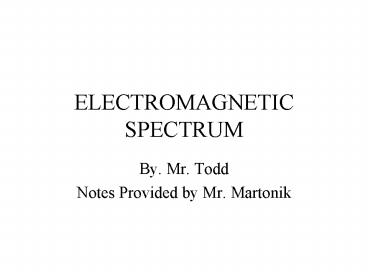ELECTROMAGNETIC SPECTRUM PowerPoint PPT Presentation
1 / 23
Title: ELECTROMAGNETIC SPECTRUM
1
ELECTROMAGNETIC SPECTRUM
- By. Mr. Todd
- Notes Provided by Mr. Martonik
2
Brief review Water and sound waves transfer
energy from one place to another- they require a
medium through which to travel. They are
mechanical waves.Electric field-region in which
charged particles can be pushed or pulled.
3
Nature of Electromagnetic Waves
- They are Transverse waves without a medium. (They
can travel through empty space) - They travel as vibrations in electrical and
magnetic fields. - Have some magnetic and some electrical
properties to them. - Speed of electromagnetic waves 300,000,000
meters/second (Takes light 8 minutes to move from
the sun to earth 150 million miles at this
speed.)
4
- When an electric field changes, so does the
magnetic field. The changing magnetic field
causes the electric field to change. When one
field vibratesso does the other. - RESULT-An electromagnetic wave.
- Click here ?Animation Interaction of vibrating
charges
5
- Waves or Particles
- Electromagnetic radiation has properties of waves
but also can be thought of as a stream of
particles. - Example Light
- Light as a wave Light behaves as a transverse
wave which we can filter using polarized lenses. - Light as particles (photons)
- When directed at a substance light can knock
electrons off of a substance (Photoelectric
effect)
6
B. Waves of the Electromagnetic Spectrum
- Electromagnetic Spectrumname for the range of
electromagnetic waves when placed in order of
increasing frequency - Click here ?(AnimationSize of EMwaves)
GAMMA RAYS
ULTRAVIOLET RAYS
RADIO WAVES
INFRARED RAYS
X-RAYS
MICROWAVES
VISIBLE LIGHT
7
RADIO WAVES
- A. Have the longest wavelengths and lowest
frequencies of all the electromagnetic waves. - B. A radio picks up radio waves through an
antenna and converts it to sound waves. - C. Each radio station in an area broadcasts at a
different frequency. on radio dial tells
frequency. - D. MRI (MAGNETIC RESONACE IMAGING)
- Uses Short wave radio waves with a magnet to
create an image
8
MRI of the Brain
9
AMAmplitude modulationwaves bounce off
ionosphere can pick up stations from different
cities. (535kHz-1605kHz vibrate at 535 to 1605
thousand times/second)
10
FMFrequency modulationwaves travel in a
straight line through the ionosphere--lose
reception when you travel out of
range. (88MHz-108MHz vibrate at 88million to
108million times/second)
11
Bands of Radio/TV/Microwaves
12
MICROWAVES
- Microwaveshave the shortest wavelengths and the
highest frequency of the radio waves. - Used in microwave ovens.
- Waves transfer energy to the water in the food
causing them to vibrate which in turn transfers
energy in the form of heat to the food. - Used by cell phones and pagers.
- RADAR (Radio Detection and Ranging)
- Used to find the speed of an object by sending
out radio waves and measuring the time it takes
them to return.
13
INFRARED RAYS
- Infrared below red
- Shorter wavelength and higher frequency than
microwaves. - You can feel the longest ones as warmth on your
skin - Heat lamps give off infrared waves.
- Warm objects give off more heat energy than cool
objects. - Thermograma picture that shows regions of
different temperatures in the body. Temperatures
are calculated by the amount of infrared
radiation given off. Therefore people give off
infrared rays.
14
(No Transcript)
15
VISIBLE LIGHT
- Shorter wavelength and higher frequency than
infrared rays. - Electromagnetic waves we can see.
- Longest wavelength red light
- Shortest wavelength violet (purple) light
- When light enters a new medium it bends
(refracts). Each wavelength bends a different
amount allowing white light to separate into its
various colors ROYGBIV.
16
(No Transcript)
17
ULTRAVIOLET RAYS
- Shorter wavelength and higher frequency than
visible light - Carry more energy than visible light
- Used to kill bacteria. (Sterilization of
equipment) - Causes your skin to produce vitamin D (good for
teeth and bones) - Used to treat jaundice ( in some new born babies.
- Too much can cause skin cancer.
- Use sun block to protect against (UV rays)
18
X- RAYS
- Shorter wavelength and higher frequency than
UV-rays - Carry a great amount of energy
- Can penetrate most matter.
- Bones and teeth absorb x-rays. (The light part of
an x-ray image indicates a place where the x-ray
was absorbed) - Too much exposure can cause cancer
- (lead vest at dentist protects organs from
unnecessary exposure) - Used by engineers to check for tiny cracks in
structures. - The rays pass through the cracks and the cracks
appear dark on film.
19
(No Transcript)
20
GAMMA RAYS
- Shorter wavelength and higher frequency than
X-rays - Carry the greatest amount of energy and penetrate
the most. - Used in radiation treatment to kill cancer cells.
- Can be very harmful if not used correctly.
21
Using the EM waves to view the Sun
- AnimationView a Galaxy at different wavelengths
22
- Brief SUMMARY
- A. All electromagnetic waves travel at the same
speed. (300,000,000 meters/second in a vacuum. - B. They all have different wavelength and
different frequencies. - Long wavelength-?lowest frequency
- Short wavelength? highest frequency
- The higher the frequency the higher the energy.
23
(No Transcript)

